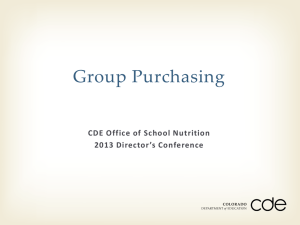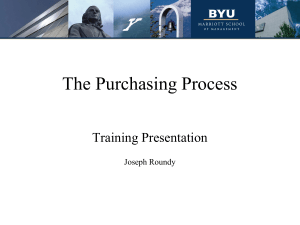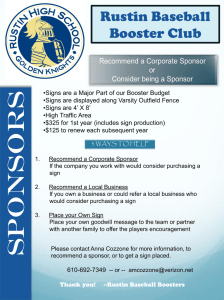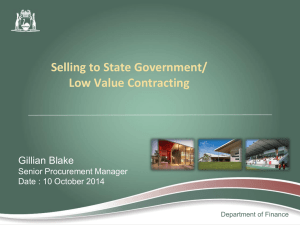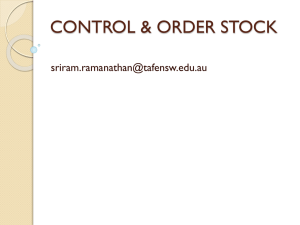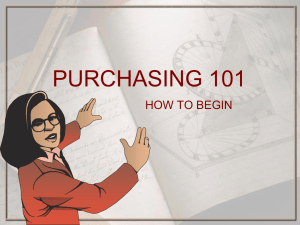Chapter_12
advertisement
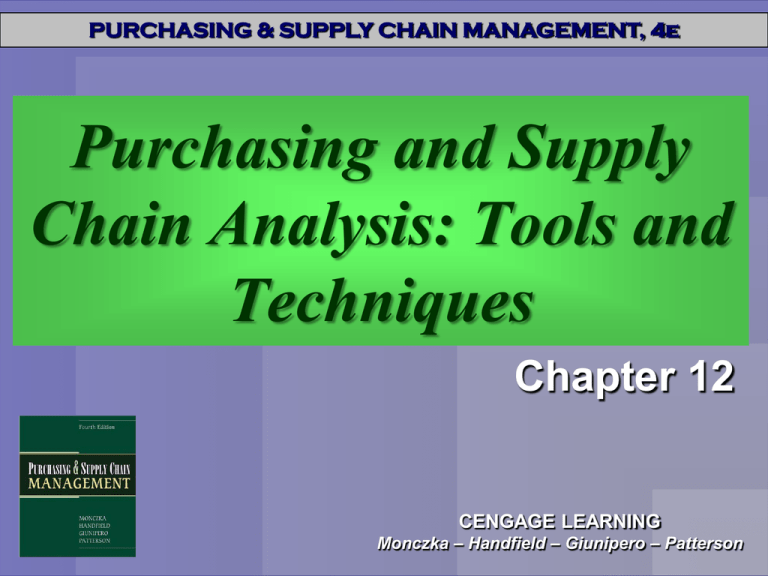
PURCHASING & SUPPLY CHAIN MANAGEMENT, 4e Purchasing and Supply Chain Analysis: Tools and Techniques Chapter 12 CENGAGE LEARNING Monczka – Handfield – Giunipero – Patterson Chapter Overview Project management Learning curve analysis Value analysis/value engineering Quantity discount analysis Process mapping Purchasing & Supply Chain Management, 4e 2 Project Management Project management is defined as a series of tasks that: Require the completion of specific objectives Has defined start and stop dates Consumes resources, particularly time, personnel, and budget Operates with limited resources Purchasing & Supply Chain Management, 4e 3 Examples in Supply Management Developing new products Developing and implementing new management information systems Conducting and implementing value analysis projects Developing and implementing sourcing strategy Supplier development initiatives Purchasing & Supply Chain Management, 4e 4 Defining Project Success Within allocated time and budget At the proper performance or specification level determined by the project’s goals and objectives At a level specified by the customer, user, or management With minimal or only mutually agreed upon changes Without disturbing the other work of the organization 5 Considerations of a Project Ensure objectives and outcomes are championed by senior management Place the project under leaders with proper skills, credentials, and credibility Establish an effective governance process through a cross-functional team Purchasing & Supply Chain Management, 4e 6 Considerations of a Project Maintain active participation from team members Break down the project into phased deliverables Manage expectations continuously and consistently Measure objectively Ensure rapid problem resolution Purchasing & Supply Chain Management, 4e 7 Project Phases Concept Project definition Planning Preliminary studies Performance Postcompletion Abstract Start Concrete Finish Purchasing & Supply Chain Management, 4e 8 Concept Phase Initiate broad discussion of project Identify broad constraints Create initial budget estimates Purchasing & Supply Chain Management, 4e 9 Project Definition Phase Develop project description Describe how to accomplish the work Determine tentative timing Identify broad budget, personnel, resource requirements Purchasing & Supply Chain Management, 4e 10 Planning Phase Develop detailed plans identifying tasks, timing, budgets, and resources Create organization to manage the project Purchasing & Supply Chain Management, 4e 11 Preliminary Studies Phase Validate the assumptions made in the project plan through interviews, data collection, literature search, and experience Purchasing & Supply Chain Management, 4e 12 Performance Phase Execute the project plan Perform the work Use project control tools and techniques Purchasing & Supply Chain Management, 4e 13 Postcompletion Phase Confirm project results to specifications Reassign personnel Restore equipment and facilities Document project files for future reference Purchasing & Supply Chain Management, 4e 14 Project Planning and Control Gantt charts Critical path method (CPM) Use when there is a single known time for each activity with no variance Program evaluation and review technique (PERT) Use where time estimates are variable or uncertain Most likely vs. pessimistic vs. optimistic Purchasing & Supply Chain Management, 4e 15 Gantt Chart Example TASK \ WEEK 1 2 3 4 5 6 7 8 9 10 11 12 13 14 15 16 17 18 19 20 21 Define supplier equipment and technology requirements Ready equipment for transfer Transport equipment to supplier Install and test equipment Train supplier personnel Ramp up to full production Purchasing & Supply Chain Management, 4e 16 Network Rules 1. Identify each unique activity by a capital letter that corresponds only to that activity. 2. A unique branch or arrow represents each activity in the project. Circles or nodes represent events. A Purchasing & Supply Chain Management, 4e 17 Network Rules 3. This diagram means only that B cannot start until A is complete. A B 4. Branch direction indicates the general progression in time from left to right. Purchasing & Supply Chain Management, 4e 18 Network Rules 5. When a number of activities end at one event, no activity starting at that event may begin until all activities ending at that event are complete. B D C Purchasing & Supply Chain Management, 4e 19 Network Rules 6. Two or more activities cannot share graphically the same beginning and ending events. K Not allowed L K Allowed L 20 Network Rules 7. Networks start and finish at only a single event. A Not allowed B A Allowed B 21 Network Example Activity Designation Preceding Activity Assemble project team A Identify potential commodity suppliers B A Develop supplier evaluation criteria C A Develop supplier audit form D C Perform preliminary supplier financial analysis E B Conduct supplier site visits F E, D Compile results from site visits G F Identify requirements for supplier performance system H A Perform detailed systems analysis and programming I H Test computerized system J I Select final suppliers K G Purchasing & Supply Chain Management, 4e 22 Network Example F E G B A D K C J H I Purchasing & Supply Chain Management, 4e 23 Learning Curves Establish the rate of improvement due to learning as producers realize direct labor cost improvements as production volumes increase The learning rate represents the improvement as production doubles 85% learning rate indicates that direct labor declines by 15% each time production doubles Purchasing & Supply Chain Management, 4e 24 Learning Curve Components Ability of the workforce to learn and improve through repetitive effort and increased efficiency Effort by management to purse productivity gains Modification to the process New production methods Increased automation Vertical integration cost control Purchasing & Supply Chain Management, 4e 25 When to Use the Learning Curve Not all processes or items are subject to learning curve effects When a supplier uses a new production process for the first time When a supplier produces a technically complex item for the first time When an item has high direct labor content Purchasing & Supply Chain Management, 4e 26 Value Analysis/Value Engineering Involves examining all elements of a component, assembly, end product, or service to make sure that it fulfills its intended function at the lowest total cost Value = Function ÷ Cost Purchasing & Supply Chain Management, 4e 27 Who Is Involved in VA/VE? Executive management Suppliers Supply management Design engineering Marketing Production Industrial/process engineering Quality control Purchasing & Supply Chain Management, 4e 28 Tests for Determining Value Does the use of this product contribute value to our customers? Is the cost of the final product proportionate to its usefulness? Are there additional uses for this product? Does the product need all its features or internal parts? Purchasing & Supply Chain Management, 4e 29 Tests for Determining Value Are product weight reductions possible? Is there anything else available to our customers given the intended use of the product? Is there a better production method to produce the item or product? Purchasing & Supply Chain Management, 4e 30 Tests for Determining Value Can a lower cost standard part replace a customized part? Are we using the proper tooling considering the quantities required? Will another dependable supplier provide materials, components, or subassemblies for less? Purchasing & Supply Chain Management, 4e 31 Tests for Determining Value Is anyone currently purchasing required materials, components, or subassemblies for less? Are there equally effective but lower cost materials available? Do material, labor, overhead, and profit equal the product’s cost? Are packaging reductions possible? Purchasing & Supply Chain Management, 4e 32 Tests for Determining Value Is the item properly classified for shipping purposes to receive the lowest transportation rates? Are design or quality specification too tight given customer requirements? If we are making the item now, can we buy it for less? Or vice versa? Purchasing & Supply Chain Management, 4e 33 The Value Analysis Process Gather information Speculate Analyze Recommend and execute Summarize and follow up Purchasing & Supply Chain Management, 4e 34 Gather Information Stage What does this product do for the customer? Why does a customer buy this product? Primary vs. secondary functions Name each function with a noun and a verb Collect detailed product information Purchasing & Supply Chain Management, 4e 35 Speculate Stage Wide-open, creative thinking Use brainstorming or other idea creating techniques Develop as many improvement ideas as possible without judgment Purchasing & Supply Chain Management, 4e 36 Analyze Stage Perform critical evaluation of ideas created in speculate stage Cost/benefit analyses Feasibility assessment Do ideas address the original goals and objectives? General specific Purchasing & Supply Chain Management, 4e 37 Recommend and Execute Stage Determine priorities Make proposal to management for approval Requires: Motivation and creativity Good communication skills Analytical thinking and product knowledge Commitment and salesmanship Purchasing & Supply Chain Management, 4e 38 Recommend and Execute Stage Implement Timing Budget Responsibilities Generate support from outside the team Purchasing & Supply Chain Management, 4e 39 Summarize and Follow Up Stage Ensure that progress is being made VA team may follow up Another team may have this responsibility Purchasing & Supply Chain Management, 4e 40 Quantity Discount Analysis Allows buyer to verify that quantity discounts are reasonable Buyer may be able to negotiate price improvements through a better understanding of incremental unit costs Prices at specific quantities vs. prices at quantity ranges Purchasing & Supply Chain Management, 4e 41 Quantity Discount Analysis Number of units/order 1 3 6 10 Price/unit (quoted) $85.00 $80.00 $70.00 $69.00 Total price/order $85.00 $240.00 $420.00 $690.00 Price difference between orders $85.00 $155.00 $180.00 $270.00 Quantity difference/order 1 2 3 4 Price/unit/order quantity difference $85.00 $77.50 $60.00 $67.50 Purchasing & Supply Chain Management, 4e 42 Quantity Discount Analysis Quantity Total Cost Incremental Quantity Incremental Cost 1 $85.00 1 $85.00 3 $240.00 2 3 $77.50 $77.50 6 $420.00 4 5 6 $60.00 $60.00 $60.00 10 $690.00 7 8 9 10 $67.50 $67.50 $67.50 $67.50 Purchasing & Supply Chain Management, 4e 43 Process Mapping Reduces processes to their component parts or activities Helps identify and then eliminate nonvalue-added activities (waste) or delays Process is defined as an outcome of a set of tasks, activities, or steps Cross multiple functional boundaries Groups have conflicting goals Purchasing & Supply Chain Management, 4e 44 Process Mapping Types: Sequential processes Concurrent processes Often used by cross-functional teams Generates buy-in from affected groups Purchasing & Supply Chain Management, 4e 45 Process Mapping Example Step # Activity Average Time Required 1 Employee 1 physically places trailer at receiving dock 15 minutes 2 Employee 2 unloads the trailer with material handling equipment 30 minutes 3 4 Employee 3 checks load quantity from the trailer against shipping documents for accuracy Employee 4 acknowledges receipt of the material on the computer and prints control tickets to move material to required warehouse locations 30 minutes 60 minutes 5 Employee 5 attaches control tickets to individual loads 20 minutes 6 Employee 6 inspects inbound material 30 minutes 7 Employee 7 moves material to required warehouse location, freeing up the receipt line for another trailer 30 minutes 8 Employee 4 files copy of shipping documents and forwards copies to Accounts Payable at the end of the day (no physical movement required) Total Average Time to Unload Trailer (excludes Step # 8) Non-value-adding Purchasing & Supply Chain Management, 4e 15 minutes 215 minutes Value-adding 46 Process Mapping Example • Step #1 • Step #2 Step #3 Remove non-value-adding steps Seek to combine other steps Step #4 Step #5 Step #6 Step #7 Hour 1 Non-value-adding Hour 2 Hour 3 Hour 4 Value-adding Purchasing & Supply Chain Management, 4e 47

